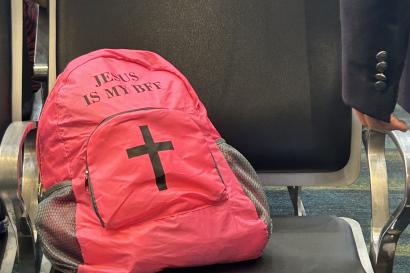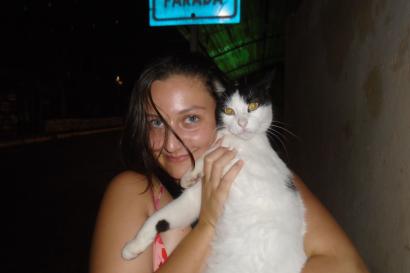As I write this, tomorrow I’ll be getting on a plane to the Galápagos Islands where I’ll be living for the next two months. It’s a place I’ve been dreaming about visiting since I got hooked on biology my sophomore year of high school, and it seems surreal that I’m this close to stepping foot on the same islands where Darwin collected samples that led to his theory of evolution. When I signed up to study abroad in Ecuador, this is all I could think about—but now that I’ve been living in Quito for a month I realize that this program is giving me so much more. Mainland Ecuador is more vibrant and diverse than I could ever capture in one anecdote, so instead I want to share with you a few things I’ve learned during my time here:
There is no such thing as a full bus
One of the more difficult things we had to learn how to navigate here was the bus system. Well, more like the lack thereof. There aren’t posted bus routes or bus times in the Quito area, so you just have to know which buses run near your house and wait for one to show up. I’m not sure if this is the reason everyone packs onto buses here or if it’s just bus culture, but no matter how many people are jammed onto a bus, more people will get on. Rumbling down the cobbled streets of Cumbaya crammed wall to wall with people, the buses look like sardine cans on wheels during peak travel times. Standing so close to strangers definitely takes some adjusting, but as long as you’re watching your belongings and you have a grip on a handle, there is always room for more people.
If you think you’ve tried every type of fruit, you’re wrong
My favorite thing about meals here in Ecuador is easily the fruit (followed closely by the aji, a freshly made spicy sauce always served with meals). I’ve tried more new fruits here in the past month than I think I have in my whole life. Maracuya (passionfruit), naranjilla (a citrusy little almost-clementine), and tomate de arbol (tree tomato, which tastes kind of like tomato but much sweeter) are just a few of the most common fruits I’ve tried for the first time here, but there have been countless others. It seems like every time I sit down to eat I’m served juice (which here is thicker like a smoothie made of the fruit, water, and sugar) from a different exotic fruit. Since most of them are grown locally, fruit is also super cheap; about a third of the price of fruit in the U.S.. Because of this, fruit or fruit juice are usually a part of every meal.
Anything higher than a $20 bill is no longer useable currency
Things are generally much cheaper in Ecuador, and most of the time vendors don’t have change for big bills. Multiple times here I haven’t been able to make a purchase because I was trying to pay with a twenty. If you travel to Ecuador, try to break bills whenever you can so that you have dollar coins handy. This is especially true at places like the indigenous market at Otovalo, where we spent our second Saturday here buying beautifully woven fabrics, jewelry, and other handicrafts.
Always check to see if the toilet paper is out before entering a stall
Let’s just say I’m glad I carry kleenex with me.
60 degrees is winter coat weather
Something really funny to me is what people in Quito define as cold. To them, any weather about 70 degrees or below was cold, and prompted my host abuela to have grave concern that I was wearing open-toe shoes. Because the weather in Quito can be really variable, with sun beating down one hour and pouring rain the next, people default to long sleeves and pants. Wearing shorts in the Quito area automatically makes you stand out as a tourist, so to avoid being a target for pickpocketers it’s best to wear long pants.
Soccer is a universal language
Personally, when it comes to soccer I’m about as skilled as I am at speaking Spanish (not very). But even though I don’t play myself I’ve enjoyed watching some of the other students in my program play with the locals. They have many times after classes at USFQ, but my favorite soccer game to watch was in Mindo when a couple of the guys walked onto the soccer field across from our hostel where a bunch of local kids were playing a game of soccer. The kids welcomed them into the game, and even started picking up some of the English soccer slang they were using. It didn’t matter that they were from different countries, or spoke different languages, because the game is universal.
If you’re paying more than $3 for a full lunch, you’re a chump
During our time in Quito, our group of students had one restaurant we’d go to at least a few days a week for lunch because it was right off campus and super cheap. For $3, you would get the standard “almuerzo”: soup, juice, a main course of usually chicken or fish served with rice and one other side, and a dessert. A lot of restaurants in Ecuador follow a similar business model for lunches, and the food is fantastic. Talk about getting your money’s worth.
If something gets wet in Mindo, it’s wet forever
My favorite weekend trip I’ve taken with my friends here was our trip to Mindo. Mindo is a town in the cloud forests of Ecuador, which means it has an extremely biodiverse population of birds, plants that look straight out of a BBC documentary (because they are), and enough humidity to basically be swimming while you’re walking. We would hang our clothes on chairs outside to dry sheltered from the rain, and although we were there for four days they never did.
When traveling to Ecuador, bring enough toiletries for the whole trip
Though most things are cheaper in Ecuador than in the US, the one exception is toiletries. They’re imported, which means that yesterday in preparation for the Galápagos, I bought four bottles of contact lense solution for $88. No joke, that’s more than I’ve spent on all of my transportation and Airbnbs while being here.
There is no limit to what you can put in an empanada
Empanadas are everywhere in Ecuador, and these fried pockets of calories and deliciousness can be filled with almost anything. Here I’ve had everything from the standard cheese or chicken empanada to hawaiian, plantain, and pizza flavored.
No stain is too tough for an Ecuadorian Abuela
My host abuela here is a laundry goddess. I don’t know how she does it, but even clothes I had that were stained before I came to Ecuador she has been able to make look like new. Her most impressive feat was cleaning my socks so thoroughly that the discoloration on the bottoms disappeared.
Hot springs are overrated
We spent a weekend in Banos recently, which is a tourist town about three hours from Quito known for its hot springs. I guess going into it, I was unrealistically expecting natural blue pools of water bubbling up between trees in a pristine forest. It turns out that Banos’ hot springs are two small man-made pools jammed wall to wall with tourists mandated to wear rental swim caps. Although I really can’t complain; this is the only activity I’ve done here so far that has been disappointing, and we still had a ton of fun laughing at each other for looking like a bunch of billiard balls squatting in tepid water amongst strangers.
With any activity, you’re bound to get your money’s worth
It seems like every time we spend money here, we end up getting so much for what we pay. Whether this be $6 for the most wild tubing run of my life in Mindo, or more mundane things like 20-minute Ubers that cost about $2.75, it seems like every time I take my wallet out what I get in return is worth every penny.
Don’t befriend the street dogs
While staying in Mindo, we learned this the hard way when a street dog followed us all the way back to our hostel and we had to shoo it away, breaking all our hearts in the process. In Ecuador, there are countless street dogs, and most are pretty friendly—it’s still just better to keep your distance.
Don’t expect wifi when it’s raining
This is a pretty strange thing I learned the first time it rained in Quito. The next morning I asked everyone else if their WiFi went out while it was raining, and surprisingly this was a really common problem.
Mountain views never get old
After being here a month, you’d expect the views of the surrounding mountains to become commonplace. But every day I still am awestruck by the beautiful jags and curves of the basin, the graceful way fog tumbles down the mountainside in the mornings like fingers of clouds beckoning the city to come closer, and the occasional rainbow bridging the gap between the sky and the buildings below.
I’m more than excited to be leaving for the Galápagos tomorrow, but I’ll miss this amazing region of Ecuador. Luckily, I’ll be returning to the mountains for my last two weeks of this trip—so I’ll say “adios” to the mainland then, and “chiao” to it for now.

Katie Vartenigian
<p>My name is Katie Vartenigian, and I’m a third-year biology student at the University of Maryland. After graduation, I want to go into science writing, preferably for a publication that allows me to travel. When I’m not studying, I like to read, write, play racquetball, and spend time with my friends. I can’t wait to study abroad this semester in the Galápagos and explore Ecuador!</p>









